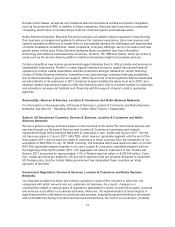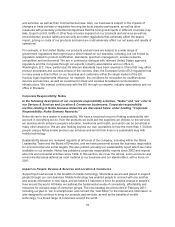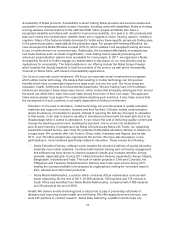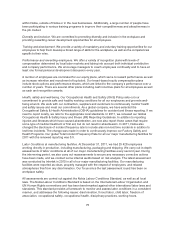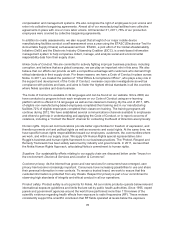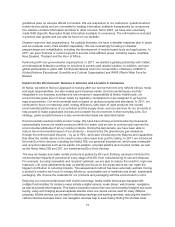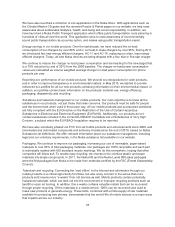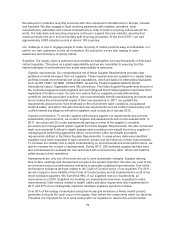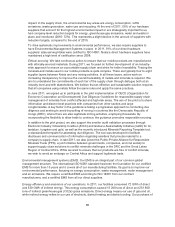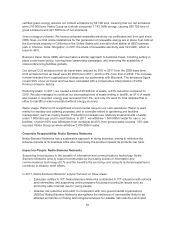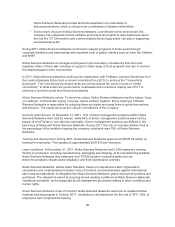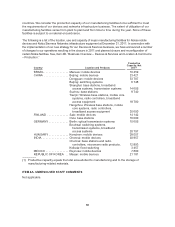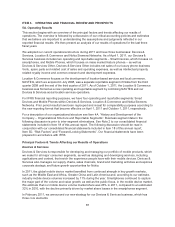Nokia 2011 Annual Report Download - page 81
Download and view the complete annual report
Please find page 81 of the 2011 Nokia annual report below. You can navigate through the pages in the report by either clicking on the pages listed below, or by using the keyword search tool below to find specific information within the annual report.We take part in collective recycling schemes with other equipment manufacturers in Europe, Canada
and Australia. We also engage in local recycling awareness with retailers, operators, other
manufacturers, authorities and various local partners in order to build a recycling culture around the
world. Our take-back and recycling programs continue to expand into new markets, assuring that
mobile products end up in environmentally safe recycling processes. At the end of 2011, we had
approximately 6 000 collection points in almost 100 countries.
Our challenge is now to engage people to make recycling of mobile products easy and desirable, not
just for our own customers, but for all consumers. By doing this, we are also helping to raise
awareness and develop a recycling culture.
Suppliers. Our supply chain is extensive and complex and altogether we have thousands of direct and
indirect suppliers. This gives us a great responsibility and we are committed to ensuring that the
highest standard of environmental and social responsibility is exercised.
Supplier requirements. Our comprehensive set of Nokia Supplier Requirements provides clear
guidance on what we expect from our suppliers. These requirements are updated on a regular basis,
and they include environmental and social expectations, which are based on international standards
such as ISO 14001, SA 8000, OHSAS18001, as well the People Capability Maturity Model,
International Labour Organization and UN conventions. The Nokia Supplier Requirements are part of
the contractual agreement with suppliers and accordingly all direct Nokia suppliers must follow them
regardless of location or size. Our aim is to ensure that our suppliers provide safe working
conditions, exercise good labor practices, use environmentally friendly manufacturing processes and
aim to reduce the environmental impact of their own operations. In 2011, we updated the
requirements and put some more emphasis on the environment, labor conditions, occupational
health & safety, and ethics. We also included new requirements such as conflict mineral policy and
conflict mineral due diligence with which suppliers must comply as of January 2012.
Supplier performance. To monitor supplier performance against our requirements and promote
sustainability improvements, we conduct supplier self-assessments and on-site assessments. In
2011, we conducted 35 on-site assessments gaining a review of the supplier’s complete
processes and management system against the Nokia Supplier Requirements. We also conducted
eight environmental & ethical in-depth assessments providing more insight into how a supplier is
managing and performing against the ethics, environment, labor and health and safety
requirements defined in the Nokia Supplier Requirements. In areas where risks were identified,
suppliers have been requested to take corrective actions and we follow up on their improvements.
To increase the visibility and in-depth understanding on environmental and social performance, we
plan to increase the number of assessments. During 2011, 292 hardware supplier facilities were
also self-assessed to evaluate the risk associated with environmental, labor, ethics and health &
safety issues in their operations.
Assessments are only one of the tools we use to drive sustainable changes. Supplier training,
face-to-face meetings and development programs are equally important. We also use a set of key
environment and social performance indicators to generate sustained improvements. One of the
performance indicators we track relates to the Code of Conduct policy of our suppliers. For 2011,
we set a target to have visibility of the Code of Conduct policy and its implementation at all of our
direct hardware suppliers. We found that 98% of our suppliers met our requirements, an
improvement on 2010. Suppliers not meeting our expectations have been requested to make
improvements. New metrics related to health, safety and labor issues were also implemented in
2011 and 97% of our strategically important hardware suppliers reported on these.
Over 50% of the energy consumption and greenhouse gas emissions a Nokia mobile product
generates during its life cycle occur in the supply chain before the components reach our factories.
Therefore it is important for us to work closely with our suppliers to reduce this environmental
79




